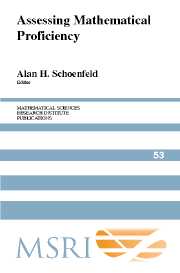Book contents
- Frontmatter
- Contents
- Preface
- Acknowledgments
- Section 1 The Big Picture
- Section 2 Perspectives on Mathematical Proficiency
- Section 3 What Does Assessment Assess? Issues and Examples
- Section 4 The Case of Algebra
- Section 5 What Do Assessments Assess? The Case of Fractions
- Section 6 The Importance of Societal Context
- Epilogue: What Do We Need to Know? Items for a Research Agenda
- About the Authors
- Subject Index
- Author Index
- Task Index
Section 2 - Perspectives on Mathematical Proficiency
Published online by Cambridge University Press: 06 July 2010
- Frontmatter
- Contents
- Preface
- Acknowledgments
- Section 1 The Big Picture
- Section 2 Perspectives on Mathematical Proficiency
- Section 3 What Does Assessment Assess? Issues and Examples
- Section 4 The Case of Algebra
- Section 5 What Do Assessments Assess? The Case of Fractions
- Section 6 The Importance of Societal Context
- Epilogue: What Do We Need to Know? Items for a Research Agenda
- About the Authors
- Subject Index
- Author Index
- Task Index
Summary
Definitions are important in education, as they are in mathematics. If one is to assess students' mathematical proficiency, then one had better start by defining the term. As the two essays in this section indicate, this is not as straightforward as it might seem. To echo R. Buckminster Fuller, a fundamental question is whether one considers mathematics be a noun or a verb. One's view makes a difference: what one defines mathematics to be has significant implications both for teaching and for assessment.
One way to view mathematics (the “noun” view) is as a wonderful and remarkably structured body of knowledge. From this perspective, the question becomes: How should that body of knowledge be organized so that students can best apprehend it? A second way to view mathematics is to think of it as What Mathematicians Do, with an emphasis on the verb. Even here, there are multiple levels of description. At the action level, for example, there are mathematical activities such as solving problems and proving theorems. At a deeper process level there are the activities of abstracting, generalizing, organizing, and reflecting (among others), which are called into service when one solves problems and proves theorems. In this section, R. James Milgram (in Chapter 4) and Alan H. Schoenfeld (in Chapter 5) explore aspects of the topics just discussed: the nature of mathematics and what it means to do mathematics, and implications of these views for both instruction and assessment.
- Type
- Chapter
- Information
- Assessing Mathematical Proficiency , pp. 29 - 30Publisher: Cambridge University PressPrint publication year: 2007



